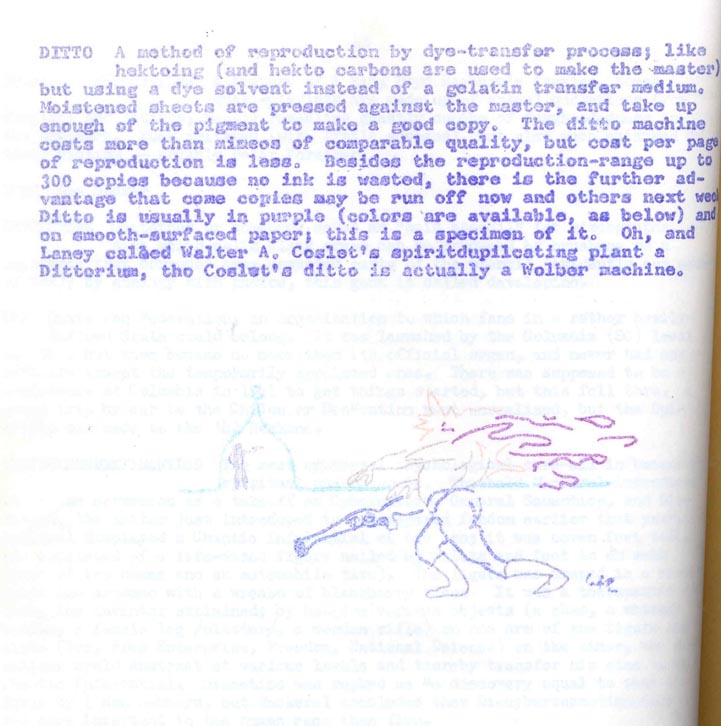Spirit Duplication
(Did you mean Ditto, a fanzine fan convention?)
Spirit Duplication was a means of fanzine reproduction (the best-known U.S. brand name was ditto) mostly remembered for the smudgy purple copies generations of schoolchildren received as classroom handouts, but being cheap and easy, with machines widely available secondhand (or, by younger fans, at school), it was also very popular with faneds, especially for short-run zines like apazines.
Some people incorrectly confuse a spirit duplicator with a mimeograph, but the latter is an ink-based process. Ditto is a dye transfer technique done with a solvent of methylated spirits, which accounts for the distinctive odor emanating from fresh copies.
Ditto masters were available in a variety of colors, enabling multi-color printing in a single pass. However, as in hectography, purple was the most readable for the longest run.
See the explanations below for the process.
- 1960s how-to film.
- “Spirit Duplicators: Early 20th Century Copier Art, Fanzines and the Mimeograph Revolution.”
| From Fancyclopedia 2, ca. 1959 |
| Ditto A method of reproducing by dye-transfer process; like hektoing (and hekto carbons are used to make the master) but using a dye solvent instead of a gelatin transfer medium. Moistened sheets are pressed against the master, and take up enough of the pigment to make a good copy. The ditto machine costs more than mimeos of comparable quality, but cost per page of reproduction is less. Besides the reproduction-range up to 300 copies because no ink is wasted, there is the further advantage that some copies may be run off now and others next week. Ditto is usually in purple (colors are available, as below) and on smooth surfaced paper; this is a specimen of it. Oh, and Laney called Walter A. Coslet's spiritduplicating plant a Dittorium, tho Coslet's ditto is actually a Wolber machine. |
| From Fancyclopedia 2 Supplement, ca. 1960 |
| This is a trademark name, to which the company owing it is ferociously attached. They didn't sue, fortunately. |
| From Fancyclopedia 1, ca. 1944 |
| Dittoing – The Ditto company's direct process is related to hektoing, but stands somewhat beyond it. Hekto carbons are used, laid face up under the master sheet, so that drawing or typing on one side of the master gives mirror writing on the other side in hekto pigment. The master sheet is put face outward around a revolving drum similar to a mimeo's, and as each copy sheet goes in, it is slitely moistened with something, and takes off just enuf of the pigment on the master to make a good copy. Besides the reproduction-range up to 300 copies because no ink is wasted, there is the further advantage that some copies may run off now and others next week. |
| Publishing |
